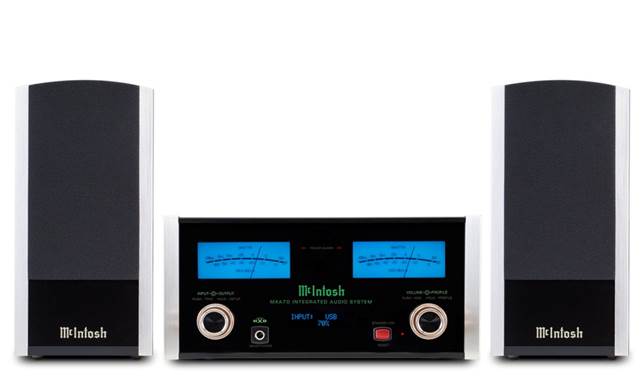Here's a small system with bags of charisma and retro
charm - but you'll have to pay big money for it
The small system isn’t a new idea. Indeed, those outside the
rarefied climes of separates hi-fi would probably regard it as the norm. After
all, do we really need yards of pressed steel casework, acres of cables and
multiple power plugs? For that reason alone, since the late seventies when
Aurex sold its first microsystem, many folks wanting decent quality sound from
a system taking up only a small space have eschewed traditional hi-fi.
In the case of the new McIntosh, there’s an extra dimension
- if you pardon the pun. You see, it’s a rather special brand. Those who are
older will have known it for a good many decades, and know that traditionally
the company makes very high quality - and seriously large - separates. Its
amplifiers are a particular favourite of mine, not just because of the sound
but also the retro styling, which has never really gone out of fashion.

McIntosh MXA70 has
a smoothness and a refinement you wouldn't expect from a mini system
In the MXA70, you see the latter in full effect. It looks
like a McIntosh amplifier that’s shrunk in the wash. The two power meters are
pure affectation; in practice they’re pretty useless because the ballistics of
the needles aren’t fast enough to capture peaks. The reason they’re fitted, of
course, is that they are iconically McIntosh; it would be like a late fifties
Chevrolet without fins, were it not thus equipped. So not only is the MXA70 a
high quality mini system, it is a McIntosh too, and advertises its status from
the moment you power it up and those meters start glowing bright blue back at
you.
The problem is that it costs $9,950, not an inconsiderable
sum. Who would pay such an amount for a product such as this? I suspect the
company wants to sell to existing customers - who doubtless have a spare
bedroom or four plus a kitchen and triple garage to fill with sound. And
there’s also that new demographic, lifestyle consumers who want a lovely thing
- that just happens to play music.

McIntosh MXA70
angle view
The MXA70 is a smallish, but not tiny one-box system that
comprises a power amplifier, DAC, analogue preamplifier and a good-quality
headphone amplifier that sports a new adaptation of McIntosh’s Autoformer
technology to give three headphone impedance ranges. Added to this, there’s a
Headphone Crossfeed Director (HXD) feature to allow high-quality recordings to
image like conventional speakers, the company says. Last but not least, there’s
a pair of very nice looking compact loudspeakers bundled, too.
The amplifier section is an old-school Class AB design using
the company’s ThermalTrak output transistors, said to have precise bias current
control for ultra-low crossover distortion. It’s claimed to deliver 50W into
8ohms, although the company says it isn’t rated for 4ohm operation. The DAC
section uses the popular Burr-Brown PCM1795 DAC chip, and offers coaxial,
optical, AES/EBU and USB inputs; two line inputs are offered, one via RCA
phones and the other via XLRs.
The supplied loudspeakers are made in the USA and are very
well presented. A 20mm dome tweeter with dampening cloth surround, said to give
high sensitivity and an extended response free of break-up modes, is fitted. At
2kHz this crosses over to a 100mm treated paper (with a rubber surround) bass
unit, using a curvilinear cone profile. A fairly complex 14-element crossover
is fitted, and sensibly includes a self-resettable fuse. McIntosh says
second-order filters are used on both midrange/bass and tweeter for improved
power handling and vertical dispersion.

McIntosh MXA70
rear view
The MXA70 is a beautiful thing to look at, with an excellent
finish. From the mirrored lower chassis to the flawless satin black of the
transformer casings, there’s nothing not to like. The binding posts are good
and chunky, and McIntosh supplies two runs of good spade-ended loudspeaker
cable. The blue fluorescent front panel display matches the power meters perfectly,
and the control knobs resemble grown-up McIntosh products, although the action
on the volume control is a bit sharp.
How to compare
It's hard to compare the McIntosh MXA70, because there's
nothing on sale quite like it. Prospective purchasers might look to something
like Naim's SuperUniti with stablemate Focal Electra II 1008 Be standmount
speakers ($5,050). It isn't quite as compact, has a wider feature set including
uPnP streaming, more power and more upgradability. The sound is considerably
better too, with a more open and dynamic character and lots more detail. It
sounds more musical, more three dimensional and as good as any other grown-up
hi-fi around at this price. That said, it isn't the wonderfully easy 'plug and
play' design that the McIntosh is.